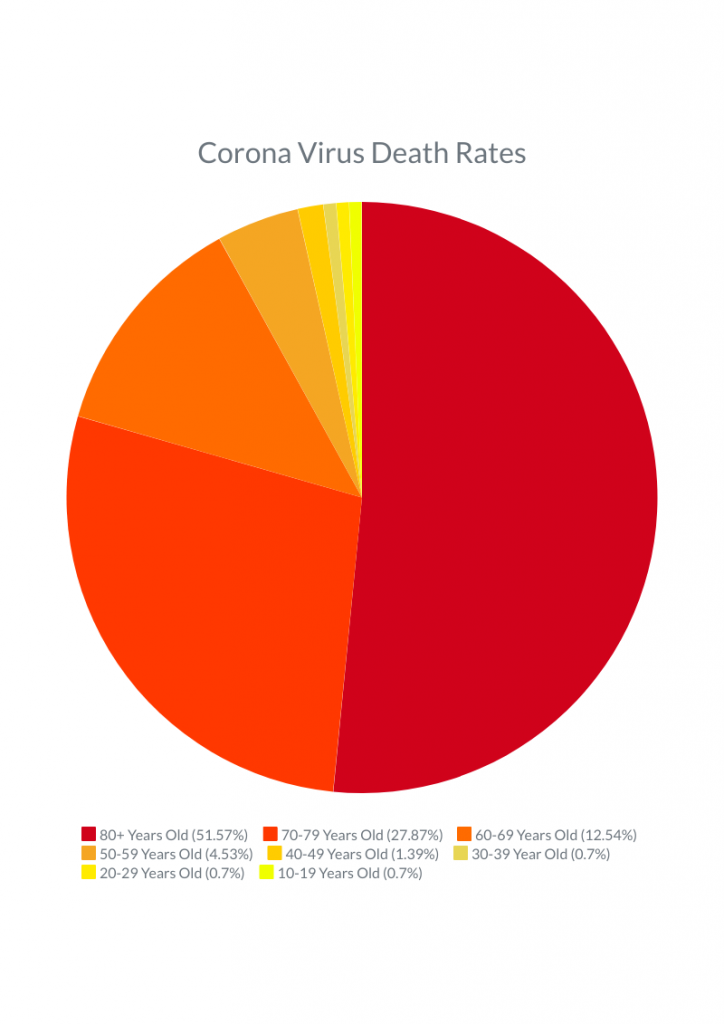By E. Cashen and L. Fitzgerald
For citation information see Works Cited page (click on “HIV/AIDS” tab above).
HIV/AIDS & COVID-19 by the numbers

By L.M. Jeansonne. Created using Piktochart.

Death rates by age group for COVID-19. By L.M. Jeansonne. Created using Piktochart. 
Death rates by age group for HIV/AIDS. By L.M. Jeansonne. Created using Piktochart.
What do we know about the virus?
HIV stands for human immunodeficiency virus; it is the virus that causes AIDS (acquired immunodeficiency syndrome). The virus weakens a person’s immune system by destroying T-cells. T-cells help fight disease and infection; when the cells are destroyed, the immune system is left vulnerable. There is no vaccine for the virus but there are ways it can be controlled (Alic).
What are the symptoms of infection? How is the infection diagnosed?
The symptoms of infection appear after an incubation period of about a month. Once the incubation period is over, flu-like symptoms appear: fever, swollen lymph nodes, night sweats, loss of energy, and muscle aches (Guilfoile et al. 30). Other symptoms that may appear are pneumonia, yeast infections, weight loss, and diarrhea. If HIV infection is left untreated then it will progress into AIDS (Alic).
The infection is diagnosed by a doctor or a home test. The home test will detect if the virus is apparent by using a kit to test oral fluid. A doctor can diagnose this through a physical exam that may include a neurological screening test. The neurological portion of the test is to detect if ADC is evident. ADC stands for AIDS Dementia Complex, which can cause memory loss from the infection (Guilfoile et al. 30).
How does the virus spread? How can it be avoided?
HIV is spread by direct contact with bodily fluids from people who have the infection. The most common ways that HIV is spread are through sexual contact, blood exchange, childbirth, breastfeeding, or the sharing of needles for illegal drugs (Guilfoile et al. 17-19).
HIV can be avoided by an infected person informing their partner of HIV status. Safer-sex tools like condoms, dental dams, and water-based lubricants (especially with condoms) can help with avoiding HIV. People at high risk of HIV can be prescribed Pre-exposure prophylaxis (PrEP) which is an antiretroviral drug that is taken daily to reduce the risk of contracting HIV/AIDS. Male circumcision can also help reduce the risk of infection during heterosexual sex (Alic).
What treatments for the disease are available? How has this changed over time?
There is no cure for the disease, but there are ways that it can be controlled and treated. There are different drugs that can be prescribed to help treat HIV. One of the most common forms of treatment is antiretroviral therapy. The treatment includes multiple antiretroviral drugs to help control the infection. If treatment is started early during the infection then it can lead to better outcomes. There is a course of antiretroviral drugs called Post-exposure prophylaxis (PEP) which is prescribed right after there is an exposure to the infection. If taken daily for a month, PEP can help prevent the infection, but it is not always completely effective. Good nutrition and exercise are also important for maintaining the well-being of people with HIV (Alic).
What is the mortality rate? Has this changed over time? Does it differ depending on age, sex, or other factors?
In 2017, the mortality rate was 2 million deaths per year, and it has significantly decreased since 2005. There were 2.3 million deaths from HIV/AIDS in 2005, and it has decreased since because of antiretroviral therapy. HIV progresses faster in children and the elderly and can cause death more quickly. Geography also affects the rate of HIV. For example, Africa has the highest mortality rate and HIV is the leading cause of childhood deaths in parts of Africa and Asia. Gender does not usually play a role in HIV, but pregnant women are more at risk (Alic).